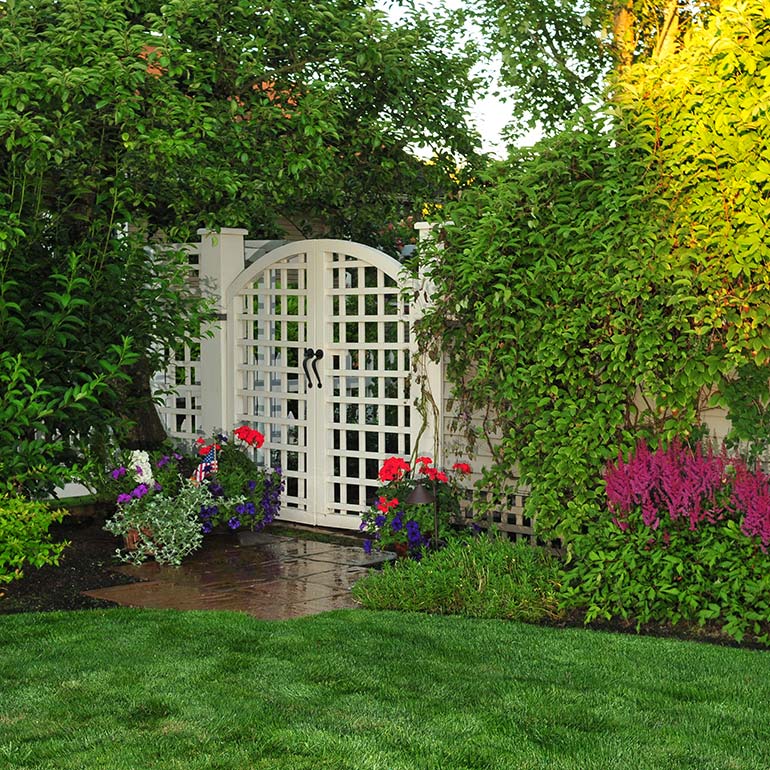Landscape Design Booklet and Garden Care Tips
Take advantage of Olympic’s free landscape design booklet that shows what you need to know before you begin your landscaping project.
Simply send us an online request or call for a free printed copy of this guide to planning, designing, and creating the outdoor landscape you have always dreamed of. Prefer to read the landscape design guide online? Simply click on the booklet to download the PDF (3MB).
Don’t want a printed version? Simply download the Landscape Design Booklet as an online PDF (3MB).
Garden and Landscaping Tips by Olympic
Tips on How to Care for Your Garden and Landscape
What landscaping tips would you like to learn more about for your yard or garden? Select from the list below to read more about your topic of interest. From lawn fertilization and watering, to pest and disease control, you can find some helpful tips on how to maintain a healthy and flourishing lawn and garden!
Tips on How to Care for Your Garden and Landscape
What landscaping tips would you like to learn more about for your yard or garden? Select from the list below to jump to your topic of interest:
Download our free PDF Landscape Design booklet.
Lawn Fertilization and Watering
Our goal is to establish a high quality turf for you to enjoy. Follow the recommendations below to get your lawn a great start. Begin by applying fertilizer 30 days after installation and 30 days again after the first fertilization.
Mixtures
Look for a lawn fertilizer with a mixture ratio of 3-1-2 (or 12-4-8). This will provide the most balanced nutrition, and ultimately the best results for the Pacific NW. You may need to try a local garden center to find this kind of mixture. We suggest that you use a slow release nitrogen on lawns with slopes or sandy soil. Mixing the slow release nitrogen with quick release fertilizer such as urea, ammonium sulfate, and ammonium nitrate may provide the results you want.
- Spread on dry grass using a Broadcast spreader.
- This spreader avoids burning.
- Sweep or blow off walks to avoid staining – iron will stain concrete.
- Always follow package direction.
Watering
An established lawn in the Puget Sound needs no more than one inch of water per week between May and September. Increased watering is necessary during the hottest points of the summer. The best time to water is in the early morning or late evening. This reduces evaporation and maintains sufficient moisture in the turf. In addition, early morning watering reduces moisture related disease problems. Make sure to adjust your automatic timers or sprinkler system to accommodate the needs of your lawn when it gets hotter.
HydroSeed – New Lawn
Good germination techniques require ample watering. Newly seeded areas must be kept moist all the time during the first two weeks after planting. We suggest watering 2-3x per day. After 2 weeks, less frequent but stronger watering is suggested. Watering three times per week for 15-10 minutes per area until your first lawn mowing.
Sod – New Lawn
The goal is to aid your lawn in establishing sufficient moisture in the turf. You can lift the corpus of new sod after watering to inspect if the water has penetrated the soil – make sure that it does!
Mowing
On a newly installed sod lawn, it is best to wait a minimum of 10 days before mowing. Never use a riding mower to begin with. We suggest that you make sure the roots are well taken, at least 1/4 inch before your first cutting.
BE AWARE: If you observe the sod pulling away from the ground due to suction of your mower, you have started too soon. Seeded lawn should be mowed no sooner than 30 days after seeding or when the lawn is 3 inches tall.
- Never cut more than 1/3 of total height.
- Remove clippings.
- Have mower blades sharpened regularly.
Mowing lawns higher results in a deeper root system, and the lawn will survive longer during a drought. Lawns with a lower mowing height results in a dense canopy. The lawn, however, will be less hardy during drought.
Edging
Remulching
Lawn Dethatching, Aeration / Overseeding
Thatching
Lawn dethatching is suggested when lawn thatch builds up to 1/2 inch or more. The best time to thatch is between March and May.
It is vital to the health of your lawn to reduce excess thatch (thatch is the organic matter that accumulates on the soil surface below the grass blade). Small amounts of thatch buildup of 1/2 inch or less can be helpful. It helps reduce evaporation and helps to protect the lawn from wear. Other ways thatch can hurt your lawn is that it can become saturated and interfere with drainage.
To add to lawn thickness, it is beneficial to seed after aeration or thatching.
Aeration
We can help your lawn avoid compaction and aid deep root growth by providing an annual core aeration performed by a power aerator. The optimum time for aeration is between March and May.
Lawn seed may be raked into the turf lightly at a rate of 4-6 pounds per 1,000 sq. feet of grass. A light application of peat moss will protect the grass seed and aid in germination.
Lawn Weeds
Basic Lawn Problems
Problem: Grass is yellow & pale
Reason: Lack of fertilizer.
Problem: Thin grass; grows poorly.
Reason: Lack of water.
Problem: Yellow/brown/dead patches
Reason: Possible insect infestation below turf. Consult a lawn care specialist.
Problem: Small, white, circular patches – green spots outlined with brown or pink threadlike substances
Reason: Possible fungal disease infestation. Consult a lawn care specialist.
Tree Shrub Fertilization
Tree Shrub Watering
First, never water ornamental trees, shrubs and ground cover during the heat of the day – this can burn the leaves. Most of these plants require a great deal of water during their initial year.
- Water thoroughly at the base of the plant as needed.
- Wet the plant’s entire root system.
- It is important to keep the soil moist, but not saturated.
Water moves vertically in soil, but not much horizontally. Thus, water over a large enough area. New plantings also require more and consistent moisture.
*Take note of drainage conditions too – insufficient or excessive watering will do damage!
Pruning
Here are the following primary pruning periods:
- Deciduous – trees / shrubs: January / February / March
- Flowering – trees / shrubs: Prune to shape – do this after flowering.
- Hedge type bushes – broad leaf evergreens: Early spring, summer and early fall
*Check with a horticulture professional before major pruning.
Wiring / Stake Removal on Trees
We suggest the removal of wiring and stakes after one growing season. Failure to remove these aids may result in a weaker tree that is often spindly. It can also result in a girdled trunk.
Leaf Removal
Still have questions about your landscaping? Contact Olympic today!


How can we help you?
Contact us by phone or use our convenient online form to request service, more information, our newsletter, or an estimate.
Call for a Phone Consultation.



